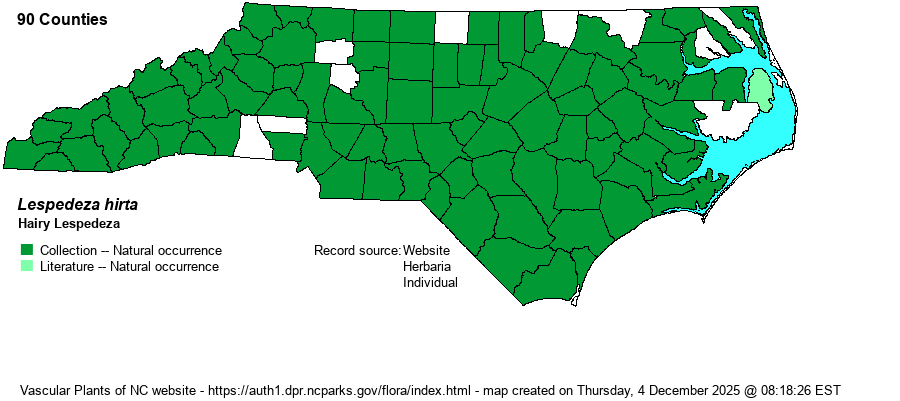| Author | (L.) Hornemann | |
| Distribution | Statewide, and presumably occurs in all 100 counties.
This is a very numerous Eastern species, found in most counties within its large range, from southern ME and central MO, south to central FL and central TX. | |
| Abundance | Common to often very common across nearly all of the Coastal Plain and Piedmont; common in the Mountains. Least numerous in the far eastern counties, where seemingly scarce on the Outer Banks. | |
| Habitat | This species grows in typical places for Desmodium and Lespedeza species -- dry to somewhat mesic borders and edges. Numerous along wooded borders, in powerline clearings, weedy fields, and other brushy places. | |
| Phenology | Blooms from August to October, and fruits from September to November. | |
| Identification | This is a rather wand-like species, as in many other lespedezas, with no or few branches, a hairy stem, and a height of about 3 feet tall. This species has the widest leaflets of any others in the genus, with each of the 3 leaflets being widely elliptical to rotund, about 1-1.2 inches long and close to 3/4-inch wide. The petiole is rather short, such that the leaflets seems to come directly off the stem. Unlike with most other Lespedeza species, the flower clusters are widely scattered, growing on long stalks from upper leaf axils, and most are held above the leaves. The clusters (spikes or dense racemes) are about 1 inch long and somewhat less wide, and the flowers are cream in color, about 1/3-inch across. This species is encountered almost daily when in the field in appropriate habitat, and most people can identify it by the quite large and rounded leaflets on a mainly unbranched stem. | |
| Taxonomic Comments | Weakley (2018) lists two varieties as occurring in NC. The nominate var. hirta occurs essentially statewide but is not common in the Coastal Plain, whereas var. curtissii is mainly found in the sandier soils of the Coastal Plain, barely into the Piedmont.
| |
| Other Common Name(s) | Hairy Bush-clover | |
| State Rank | S5 | |
| Global Rank | G5 | |
| State Status | | |
| US Status | | |
| USACE-agcp | | |
| USACE-emp | | |

